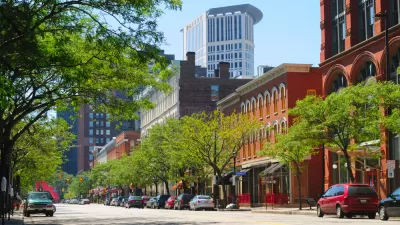Building in the New Economy isn't business as usual. Howard Blackson lays out policy, planning, land assembly and financing tools to help us with our task at hand.
Blackson lays out some of the tools we're going to be needing in 2012 and beyond, including land assembly techniques, urban planning policies, urban design regulations, local tax districts, and city-wide tax tools. He points out:
"In startling alignment with James Howard Kunstler's stark predictions, ULI's 2012 Report, 'What's Next: Real Estate in the New Economy,' bubbly concludes: 'The real estate world is hurtling into a different place and time. Change is coming at a faster pace with more uncertain consequences. Success will take on different forms and risks will increase. Standing pat or ignoring new realities is not possible. Notably, investment will gravitate to places that welcome business and view public investments - in education, infrastructure, and innovation - as prerequisites for progress and economic sustainability.'"
"Municipalities are finally looking to new models modifying their decades-long reliance upon suburban planning tools to enable infill redevelopment. Just as suburbia was built with now vanishing state and federal subsidies, the following financing tools are available to tilt the playing field towards the difficult chore of building infill redevelopment."
Thanks to Hazel Borys
FULL STORY: Money, It’s a Gas: New Economy development financing

Maui's Vacation Rental Debate Turns Ugly
Verbal attacks, misinformation campaigns and fistfights plague a high-stakes debate to convert thousands of vacation rentals into long-term housing.

Planetizen Federal Action Tracker
A weekly monitor of how Trump’s orders and actions are impacting planners and planning in America.

San Francisco Suspends Traffic Calming Amidst Record Deaths
Citing “a challenging fiscal landscape,” the city will cease the program on the heels of 42 traffic deaths, including 24 pedestrians.

Bend, Oregon Zoning Reforms Prioritize Small-Scale Housing
The city altered its zoning code to allow multi-family housing and eliminated parking mandates citywide.

Amtrak Cutting Jobs, Funding to High-Speed Rail
The agency plans to cut 10 percent of its workforce and has confirmed it will not fund new high-speed rail projects.

LA Denies Basic Services to Unhoused Residents
The city has repeatedly failed to respond to requests for trash pickup at encampment sites, and eliminated a program that provided mobile showers and toilets.
Urban Design for Planners 1: Software Tools
This six-course series explores essential urban design concepts using open source software and equips planners with the tools they need to participate fully in the urban design process.
Planning for Universal Design
Learn the tools for implementing Universal Design in planning regulations.
planning NEXT
Appalachian Highlands Housing Partners
Mpact (founded as Rail~Volution)
City of Camden Redevelopment Agency
City of Astoria
City of Portland
City of Laramie




























